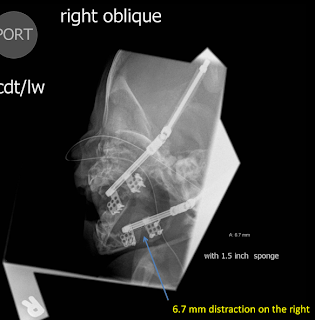UtahRad
Have an interesting case or important fact to post? Email: baskinhj@gmail.com
Friday, March 16, 2012
Tuesday, February 14, 2012
Thursday, August 4, 2011
Thursday, June 23, 2011
Friday, June 17, 2011
Friday, February 11, 2011
New device for mandibular distraction
Dr Grant Fairbanks is using a new device for mandibular distraction.
It is threaded but not ratcheted and therefore can unscrew, losing ground.
He will be obtaining followup radiographs to check the distraction every 2-3 weeks on patients and would like an AP like the image attached as well as bilateral obliques with the interested side flat against the cassette to minimize magnification and obtain a reproducible measurement. The obliques may need a little cephalic angulation to prevent superimposition of the hardware. He is interested in the distance between the two plates. Their inner margins mark the edges of the osteotomy.
Attached is a sample Powerscribe macro if you like.
It is threaded but not ratcheted and therefore can unscrew, losing ground.
He will be obtaining followup radiographs to check the distraction every 2-3 weeks on patients and would like an AP like the image attached as well as bilateral obliques with the interested side flat against the cassette to minimize magnification and obtain a reproducible measurement. The obliques may need a little cephalic angulation to prevent superimposition of the hardware. He is interested in the distance between the two plates. Their inner margins mark the edges of the osteotomy.
Attached is a sample Powerscribe macro if you like.
[] []
Clinical History: [<Pierre Robin syndrome, micrognathia, mandible distractors>]
Findings: Status post bilateral mandibular distraction. [<An enteric tube is present.>] [<There is no evidence of breakage of the hardware or loosening of the screws.>]
Distraction
Left: [] mm
Right: [] mm.
Impression: [<There is no evidence of loosening or breakage of the hardware.>]
Code [<20>]
Clinical History: [<Pierre Robin syndrome, micrognathia, mandible distractors>]
Findings: Status post bilateral mandibular distraction. [<An enteric tube is present.>] [<There is no evidence of breakage of the hardware or loosening of the screws.>]
Distraction
Left: [] mm
Right: [] mm.
Impression: [<There is no evidence of loosening or breakage of the hardware.>]
Code [<20>]
Thanks to Bill Andolsek, DO
Wednesday, January 19, 2011
iPad for Radiologists
Simplenote, an simple and elegant electronic note pad. The free iPad app syncs with the web app in real-time.
More than a virtual drumbdrive, Dropbox is a free program you download to your computer. It then creates a folder on your computer that you use like any other folder, except that the contents are automatically backed-up in realtime, stored in the cloud for you (password-protected), and will sync with your other computers. Unfortunately, IHC blocks this site, so you have to use it on your laptop or iPad when in the hospital. This link gives you a 250MB bonus: CLICK HERE. You can download the free iPad app HERE.
More to come
Subscribe to:
Posts (Atom)













